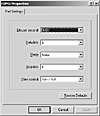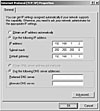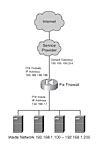Using the ASDM Startup Wizard
It's time to start with ASDM. At the end of this section, you will have a secure connection established to the Internet.
You complete the following tasks in this section:
- Connect to the ASA/PIX Security Appliance with ASDM.
- Configure the ASA/PIX Security Appliance host name and domain name and enable password.
- Configure the outside interface information.
- Configure other interface characteristics.
- Configure NAT.
Connecting to the ASA/PIX Security Appliance with ASDM
If you haven't completed the steps from Chapter 3, "Getting Started with the ASA/PIX Security Appliance," to install ASA/PIX version 7 and ASDM, you cannot proceed. You must complete the configuration portion of that chapter before you can do any of the step-by step portions of this section.
You need to complete three steps before you can connect to the ASA/PIX Security Appliance using ASDM:
|
Step 1 |
Configure an interface port. |
|
Step 2 |
Allow ASDM access to the box. |
|
Step 3 |
Ensure you have the appropriate Java Runtime Environment on your host that will be running ASDM. |
Configure an Interface Port
These steps assume that there is currently no configuration on your ASA/PIX Security Appliance. If it is the first time you boot your ASA/PIX Security Appliance, it will prompt you with a question asking whether you want to configure the device. Enter No. All of your configuration steps are outlined in the following steps.
If you already configured your security appliance as described in Chapter 3, you can skip to the section titled "Configure Your PC to Access the ASA/PIX Security Appliance."
|
Step 1 |
Plug your PC serial port into the console of the ASA/PIX Security Appliance using the serial cable. Using HyperTerminal or any terminal emulator application, set your parameters to match those in Figure 5-2. These setting show speed at 9600 bps, 8 data bits, no parity checking, and 1 stop bit. |

Figure 5-2 HyperTerminal Parameter Setup |
|
|
Step 2 |
Power on the ASA/PIX Security Appliance. The Security Appliance will go through its boot sequence and you will be presented with a pixfirewall> prompt. |
| Step 3 | You must now configure the inside interface of the ASA/PIX Security Appliance with a valid inside address so that you can access it using ASDM. At the prompt, enter the commands in the following example that are in bold text. Comment lines have been added to indicate what each command does. Comment lines are preceded with an exclamation point (!): |
|
|
pixfirewall> enable ! en - puts you in Enable (Privileged) mode. Password:<CR> ! <CR> - is the default password for the PIX. pixfirewall# configure terminal ! conf t - specifies that the following commands will be configuration commands. pixfirewall(Config)# interface ethernet ! int e1 – specifies that the commands following will be applied to the Ethernet 1 interface. pixfirewall(Config-if)# nameif inside ! nameif inside – defines Ethernet 1 as the inside or protected interface. INFO: Security level for "inside" set to 100 by default. pixfirewall(Config-if)# ip address 192.168.1.1 255.255.255.0 ! ip add 192.168.1.1 255.255.255.0 – sets the IP address and subnet mask for the inside interface. pixfirewall(Config-if)# no shut ! no shut – enables the interface for operating. pixfirewall(Config-if)#
|
In this book, this is the only time you use the native ASA/PIX Security Appliance command-line interface (CLI) to enable the security appliance to accept ASDM connections.
Configure Your PC to Access the ASA/PIX Security Appliance
Because you will be accessing ASDM with your PC on the inside interface of the ASA/PIX Security Appliance, you must configure your PC with an inside IP address. You will use 192.168.1.2 with a subnet mask of 255.255.255.0 (same as the security appliance subnet mask). The gateway is the next-hop address; so in this case, it is the address you gave to the inside of the security appliance: 192.168.1.1.
Figure 5-3 illustrates how your Network Control Panel should look when configured if you are using Windows 2000.

Figure 5-3 PC Network Configuration
You can connect the PC to the ASA/PIX Security Appliance in one of two ways. You can directly connect to the interface labeled Ethernet 1 using a crossover cable, or you can plug the PC and Security Appliance Ethernet 1 into a switch using straight-through Ethernet cables. You should now be able to ping the firewall from your PC using the command ping 192.168.1.1. If your pings are not successful, recheck your addressing and cabling. Make sure that the PC Ethernet card and Ethernet 1 on the security appliance are enabled. You should see link lights on the security appliance interface and the network card of your PC when properly configured.
Allow ASDM Access to the ASA/PIX Security Appliance
You must now tell the ASA/PIX Security Appliance that you are enabling it to run ASDM. You are also defining what IP address can access the security appliance with the ASDM application.
Follow these steps:
|
Step 1 |
The first thing you need to do is tell the PIX the name of the ASDM file. Enter the following command on the PIX: asdm image flash:/asdm.bin. |
|
Step 2 |
Now, you must enable the ASA/PIX Security Appliance to start its secure web server. Enter the command http server enable. |
|
Step 3 |
After the ASA/PIX Security Appliance web server is enabled, you must tell the security appliance who can access ASDM and where they are located. To accomplish this, enter the address of your PC and tell the security appliance you are located on the inside interface. Enter the command http 192.168.1.2 255.255.255.255 inside. |
|
Step 4 |
Enter the command show running http on the ASA/PIX Security Appliance and ensure that the output matches the following output: pixfirewall(Config)# show running http http server enabled http 192.168.1.2 255.255.255.255 inside pixfirewall(Config)# At this point, you should have full connectivity to your ASA/PIX Security Appliance via ASDM. |
Launching ASDM
The instructions in this section show you how to launch ASDM. Just follow these steps:
|
Step 1 |
Open the browser on your PC and enter https://192.168.1.1/admin. |
|
Step 2 |
This action downloads the ASDM applet to your PC. The first timeyou do this, it might take a minute to load. However, in subsequent connections, ASDM will start in just a few seconds. |
|
|
ASDM will also present you with an option to download a utility called the ASDM Launcher. This launcher is an application that functions exactly the same as the Java applet. Using this application will eliminate the need to launch a browser to access the ASA/PIX Security Appliance. |
|
|
The browser-based ASDM applet requires Java 1.4.2 or 1.5.0. If you don't have one of these Java versions installed on your PC, you will get the following message and you must download the required software: "Your browser does not have the required Java Plug-in. ASDM requires Java Plug-in version 1.4.2 or higher." We will point you to a web page from which you can download the correct Java version to your PC. |
|
|
Because ASDM is using a connection secured by SSL, you will see the various security warnings as described in the following steps. |

Figure 5-4 Valid Certificate Alert |
|
|
Step 3 |
When you get the prompt for the ASA/PIX Security Appliance username and password (Figure 5-5), leave the fields empty and click OK. You haven't set a password yet, so no input is required. |
|
Step 4 |
Figure 5-6 informs you that the certificate is going to be used as a key to encrypt data but that the issuer isn't trusted. You must click Yes to continue. Don't be concerned when you see these messages that say that certificates are not trusted. Trust is a technical concept in public certificate authentication related to the prior knowledge of a certificate. |

Figure 5-5 ASA/PIX Security Appliance Username and Password Prompt |
|

Figure 5-6 Valid Certificate Alert |
|
|
Step 5 |
Figure 5-7 prompts you again for username and password because the Java applet is now running. Again, because you haven't set passwords at this point, you should click Yes. If you are using the ASDM Launcher application rather than the web browser, you won't get this prompt. |

Figure 5-7 Network Password Access |
|
|
Step 6 |
Figure 5.8 is a certificate that needs to be approved to download the ASDM applet to your PC. Click Yes to continue. |

Figure 5-8 Certificate to Download ASDM |
|
| You are now presented with Figure 5-9, which is the ASDM Welcome screen. | |
|
|
Figure 5-9 ASDM Welcome Screen |
You are now logged on to your ASA/PIX Security Appliance using ASDM.
Using the ASDM Startup Wizard to Configure the ASA/PIX Security Appliance
Now, you are ready to begin entering configuration information into ASDM. Just follow these steps:
|
Step 1 |
To start the wizard, click the Wizard pull-down menu item or the click the Wizard option on the navigation panel to the far left of the ASDM home screen and choose Startup Wizard. |
|
Step 2 |
You will first be asked whether you want to use the existing configuration. The only existing configuration should be your IP address and the command that allows ASDM to communicate with your browser. Click Continue with Existing Configuration, and then click Next. (See Figure 5-10.) |

Figure 5-10 ASDM Starting Configuration |
|
|
Step 3 |
You are than prompted for the basic configuration (see Figure 5-11). |
|
|
Enter the name you want to call your ASA/PIX Security Appliance. Enter the domain, if you have one. You can enter anything you want in these fields; Figure 5-11 shows pixfirewall and example.com entered in these fields. The default domain name is default.domain.invalid until you enter your own domain name into this field. |
|
Step 4 |
You need to enter an enable password (privileged) for the firewall. Because no password is yet configured, leave the old password blank. According to security best practices, you should enter a password at least eight characters long, using numerals, special characters, and containing uppercase and lowercase characters. Following this rule will significantly reduce the chances of an attacker being able to run a brute-force or guessing attack against your firewall to get the password and gain full access. Click Next. |

Figure 5-11 ASDM Basic Configuration |
|
|
Step 5 |
The next step is to configure the connectivity to the Internet. This consists of the following: |
|
|
|
|
|
|
|
|
|
|
|
|
|
|
In Figure 5-12, you can see that outside is entered as the name the interface, 199.199.199.199 as the IP address, 255.255.255.0 as the subnet mask, and 199.199.199.254 as the default gateway. A default security level will be set to 0 on your outside interface. These addresses were randomly chosen for the step-by-step procedures in this book. The address you actually enter will be provided by your ISP. Although not addressed in this book, your ISP might ask you to accept a DHCP address on the outside interface. To do this, you just click the Use DHCP option button. |
|
|
Security level is important. In the ASA/PIX Security Appliance, traffic will flow unimpeded from a high-security level to a low-security level. Conversely, traffic from a low-security level to a higher-security level will be blocked by default. Later when you configure access lists, you will allow traffic from low to high. |
|
|

Figure 5-12 Outside Interface Configuration |
|
|
By default on the ASA/PIX Security Appliance, because the inside interface has a security level of 100 and the outside has a default of 0, traffic originating from the inside is allowed to pass to the outside interface. Because the ASA/PIX Security Appliance is a stateful device, this means that all traffic going through the firewall will also be allowed to return. The default security appliance behavior blocks traffic sourced from the Internet, effectively mitigating against thousands of possible attacks that can be launched against your network from the Internet. |
|
Step 6 |
The IP addresses for the outside interface listed are only an example and will not work for your network deployment. You must use the values provided by your ISP. |
|
|
Your service provider might not give you an IP address for the outside interface of your security appliance; they might require you to run DHCP and automatically configure your outside address using its DHCP server. |
|
|
The next screen is titled Other Interface Configuration. (See Figure 5-13.) In this chapter, you do not make any changes to other interfaces. In Chapter 6, you add another interface if you plan to host a web or mail server. |

Figure 5-13 Other Interface Configuration |
|
|
Step 7 |
The next screen, DHCP Server, allows you to automatically configure the IP addresses of your inside hosts. (See Figure 5-14.) As mentioned earlier in this chapter, the most expeditious way to deliver addresses to the inside is to use DHCP. If you use DHCP, the ASA/PIX Security Appliance assigns an address to each host on your inside network when the host boots up. |
|
|
To activate DHCP, click the box next to Enable the DHCP Server on the Inside Interface. |

Figure 5-14 DHCP Server Configuration |
|
|
Step 8 |
Enter a range of IP addresses that will be allocated by DHCP for your hosts. Make sure you allow enough IP addresses for all of your hosts. Use a starting address of 192.168.1.100 and an ending address of 192.168.1.200. You need to make sure that the range you use does not overlap with any other IP addresses, such as the inside interface of your security appliance (192.168.1.1) or the static address of your PC (192.168.1.2). |
|
Step 9 |
You now need to enter the DNS and WINS address that you want automatically configured on your inside hosts. If you don't have your own DNS server, the address will be given to you by your ISP. A WINS server is required if you plan to use Microsoft File or Print Sharing on your network. You need to consult with Microsoft on how to enable this on your system. You can leave this field blank. In the example, the same address as my DNS and WINS server is used. |
|
Step 10 |
To enable your PCs to accept DHCP addresses from your ASA/PIX Security Appliance, you need to go to the Network Control Panel, choose Properties, highlight Internet Protocol, choose Properties, check Obtain an IP Address Dynamically, check Obtain a DNS Server Address Dynamically, and then click OK. |
|
|
After the wizard has completed and the PCs have been configured, addresses are automatically allocated when a PC is started and connected to the inside network. |
|
Step 11 |
If you have a domain name given to you by your ISP, enter it into the Domain Name field. This is an optional field. |
|
Step 12 |
After you have filled in the values, click Next to proceed. |
|
Step 13 |
The next screen is the Address Translation screen. (See Figure 5-15.) As mentioned previously in this chapter, private inside addresses are not routable on the Internet. Therefore, you must use NAT to translate the private addresses and allow them access to and from the Internet. In your case, you are going to use something called port address translation (PAT), which uses a combination of something called a port and the outside address of the ASA/PIX Security Appliance. Using PAT simplifies the configuration steps for address translation; in addition, because you are using an existing address, you don't need to purchase additional addresses from you ISP. |
|
|
Click the Use Port Address Translation option button, click the Use Port on the Outside Interface option button, and then click Next to continue. |

Figure 5-15 Address Translation |
|
|
Step 14 |
Now, you must select which IP addresses are allowed to have administrative access to your ASA/PIX Security Appliance. This specification should already be set or you wouldn't have access to ASDM. If you need to add additional authorized IP addresses, choose an interface and click Add. Then, enter the data for the PC for which you need to allow access. Click Next. This value should already be set from when you used the CLI to configure the security appliance to allow access from 192.168.1.2. (See Figure 5-16.) |

Figure 5-16 ASDM Configuration Panel |
|
|
Step 15 |
Click Finish. |
|
|
The ASA/PIX Security Appliance then automatically generates and sends commands to the security appliance according to the selections that you made during the wizard configuration process. |
Congratulations! You now have a secure, working connection to the Internet.
When the Startup Wizard has completed, the resulting addresses of your network display, as shown in Figure 5-17.

Figure 5-17 Server Topology
You are now protected from several hundred attacks that can originate from the Internet because traffic is allowed only from the inside out. In addition, by default, many processes are running on your firewall to help protect it from DoS attacks. You are still susceptible to many other attacks, such as mail- and web-based viruses, but in subsequent chapters, you are instructed on how to mitigate these threats.
